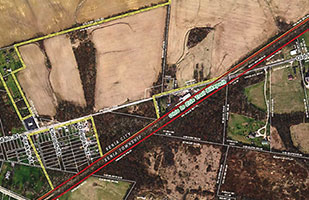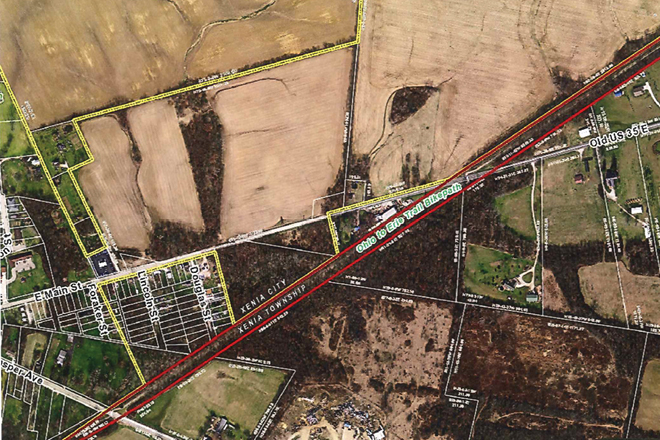Court Approves Annexation of Central State University Land Via Bike Trail

Xenia’s “balloon on a string” annexation uses a bike trail to attach to a triangular parcel of land.

Xenia’s “balloon on a string” annexation uses a bike trail to attach to a triangular parcel of land.
The Ohio Supreme Court today approved the city of Xenia’s proposed “balloon-on-a-string” annexation of land used by Central State University, finding the plan met all the conditions of the state’s expedited annexation process.
In a unanimous per curiam decision, the Supreme Court affirmed the Second District Court of Appeals grant of a writ of mandamus to the city, which ordered the Greene County Board of County Commissioners to approve the annexation sought by the university and the city. The commissioners had sided with Xenia Township, which objected to the annexation.
At the center of the debate was the way the city and the university would be connected. The city is annexing a 41-acre strip of bike trail along a former railway that connects to a 4.5-acre triangular plot of Central State land. The Court’s opinion noted that it previously disfavored “strip,” “shoestring,” or “corridor” annexations under Ohio’s traditional annexation scheme, but annexation reforms adopted by state lawmakers in 2001 permit them.
Commission Rejected Annexation
In 2001, the state developed three procedures allowing for expedited annexations when all the property owners within the area to be annexed sign an annexation petition. The Xenia-Central State annexation follows what is known as a “Type 2” annexation and is governed by R.C. 709.023. The residents of the area of a Type 2 annexation become residents of both the municipality and the township, subject to taxation by both, and able to receive services from either.
In announcing its support for the annexation, Central State said it currently contracts with the city of Xenia for water, sewer, fire, and emergency medical services. After annexation the university would not have to pay a surcharge for the services. Also, its 350 employees would pay income tax to Xenia.
The process required Xenia to file an annexation petition with the Greene County commissioners and adopt an ordinance or resolution specifying the services it would provide to the annexed land. A township or municipality that opposes the annexation can file objections with the commission, which Xenia Township did, referring to the way the annexation was plotted as resembling “a balloon on a string,” with the balloon being the university and the string being the bike path.
Once the objections were submitted, the county commission had to determine if the petition met seven conditions listed in R.C. 709.023(E). The township argued the city’s proposal failed to meet several conditions, especially R.C. 709.023(E)(4), which requires that the annexed territory “shares a contiguous boundary with the municipal corporation to which annexation is proposed for a continuous length of at least 5 percent of the perimeter of the territory proposed for annexation.”
The county denied the city’s petition, so Xenia sought a writ from the Second District to compel the county to approve the annexation. The Second District granted the writ and ordered the county to approve the transaction. The county appealed to the Supreme Court, which was required to consider the appeal because the county’s request for a writ originated in the court of appeals.
Expedited Annexation Requirements Differ from Traditional Ones
The county claimed the city is not entitled to the order forcing board approval because, the county argued, it had discretion under R.C. 709.023(E) to deny the annexation. The Supreme Court opinion stated the law is tightly written to remove discretion. The Court noted that under “traditional” annexation, the board had to consider whether “the general good of the territory proposed to be annexed will be served” by the annexation. However, the seven conditions in the expedited annexation process do not contain “this type of open-ended language.”
Citing the Court’s 2017 State ex. Rel. Natl. Lime & Stone Co. v. Marion Cty. Bd. of Commrs. decision, the opinion stated that when all seven conditions are met, the commissioners have no discretion to deny the petition.
The commission also maintained the city failed to meet the “contiguity requirements” of the law. The commissioners maintained that the Court should rely on the definition of “contiguous” t adopted in the Court’s 1988 Middletown v. McGee decision.
The Court explained in McGee that the law was unsettled on what degree of border touching is needed to fulfill the contiguity requirement, but found there is general agreement that “some touching of the municipality and the territory to be annexed is required.” That opinion, and others that followed, disfavored using connecting strips to meet the requirement, which is what Xenia proposed to do by using a bike trail to connect to Central State, the opinion noted.
The Court stated that at the time of McGee there was no definition in the law for “contiguous.” However, the General Assembly has defined the minimum degree of touching for a Type-2 annexation, which is a length of 5 percent.
Annexation Meets Land Requirement
The city calculated that the perimeter of the proposed annexed territory is 36,302 feet and has a contiguous boundary of 1,929 feet. That equates to a shared boundary of roughly 5.31 percent of the territory’s perimeter.
The county determined the perimeter was 38,137 feet and agreed with the city that the contiguous boundary was 1,929 feet. That is roughly 5.03 percent of the territory’s boundary. The Court determined that while the numbers slightly diverge, the shared boundary exceeds the 5 percent threshold called for in the law.
The county urged the Court to consider that the city announced future plans to annex an additional 159 acres, with some of the land owned by Central State, through the bike trail connection. The county argues if the 159 acres were added, the shared boundary would fall to 4.29 percent.
The opinion stated the law requires the county to consider the land in the petition, and not Xenia’s intent to annex land at some future time.
“We decline the county’s invitation to rewrite the statute by considering the city’s future plans,” the Court stated.
2019-1791. State ex rel. Xenia v. Greene Cty. Bd. of Commrs., Slip Opinion No. 2020-Ohio-3423.
Please note: Opinion summaries are prepared by the Office of Public Information for the general public and news media. Opinion summaries are not prepared for every opinion, but only for noteworthy cases. Opinion summaries are not to be considered as official headnotes or syllabi of court opinions. The full text of this and other court opinions are available online.
Acrobat Reader is a trademark of Adobe Systems Incorporated.


